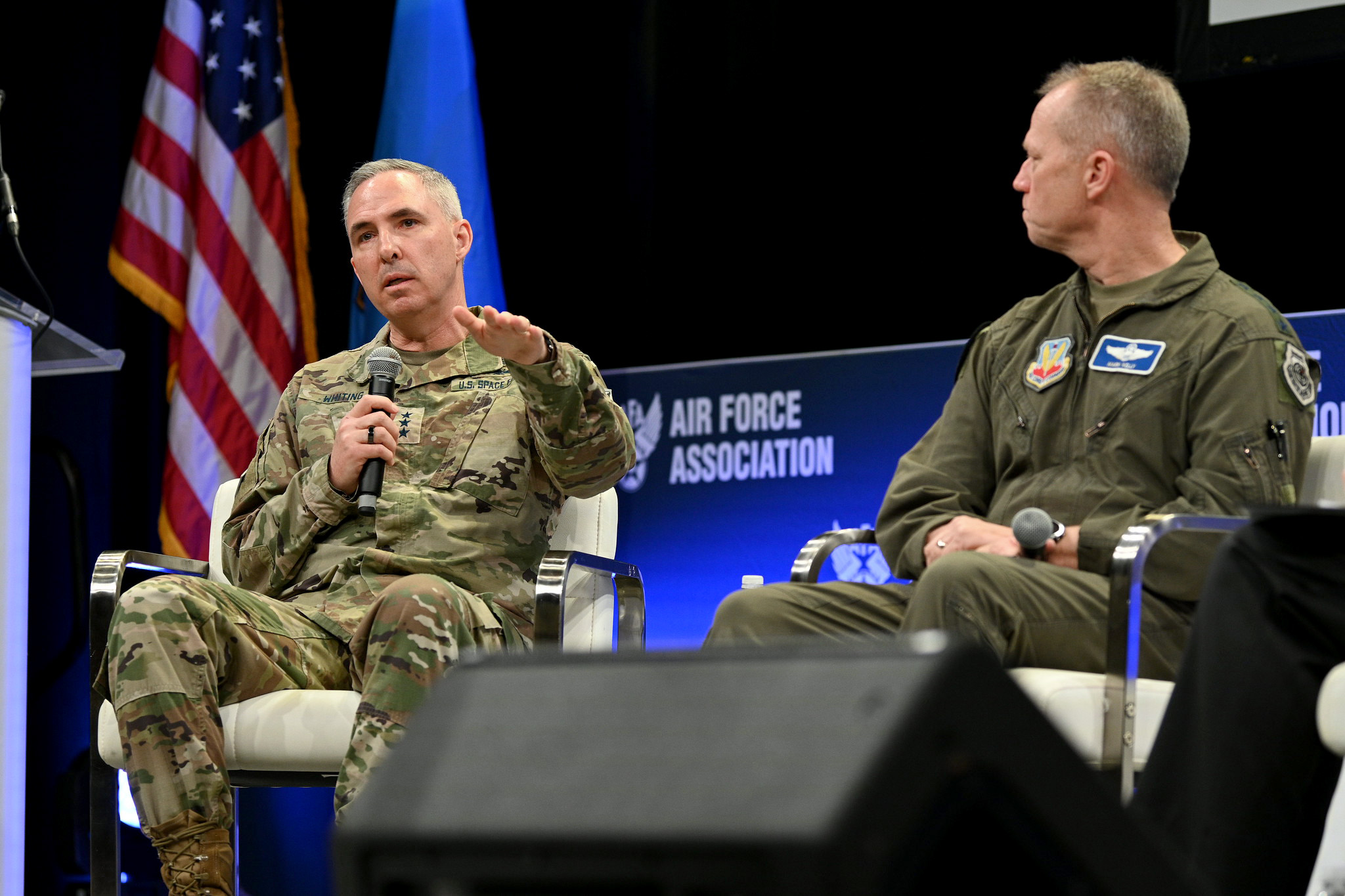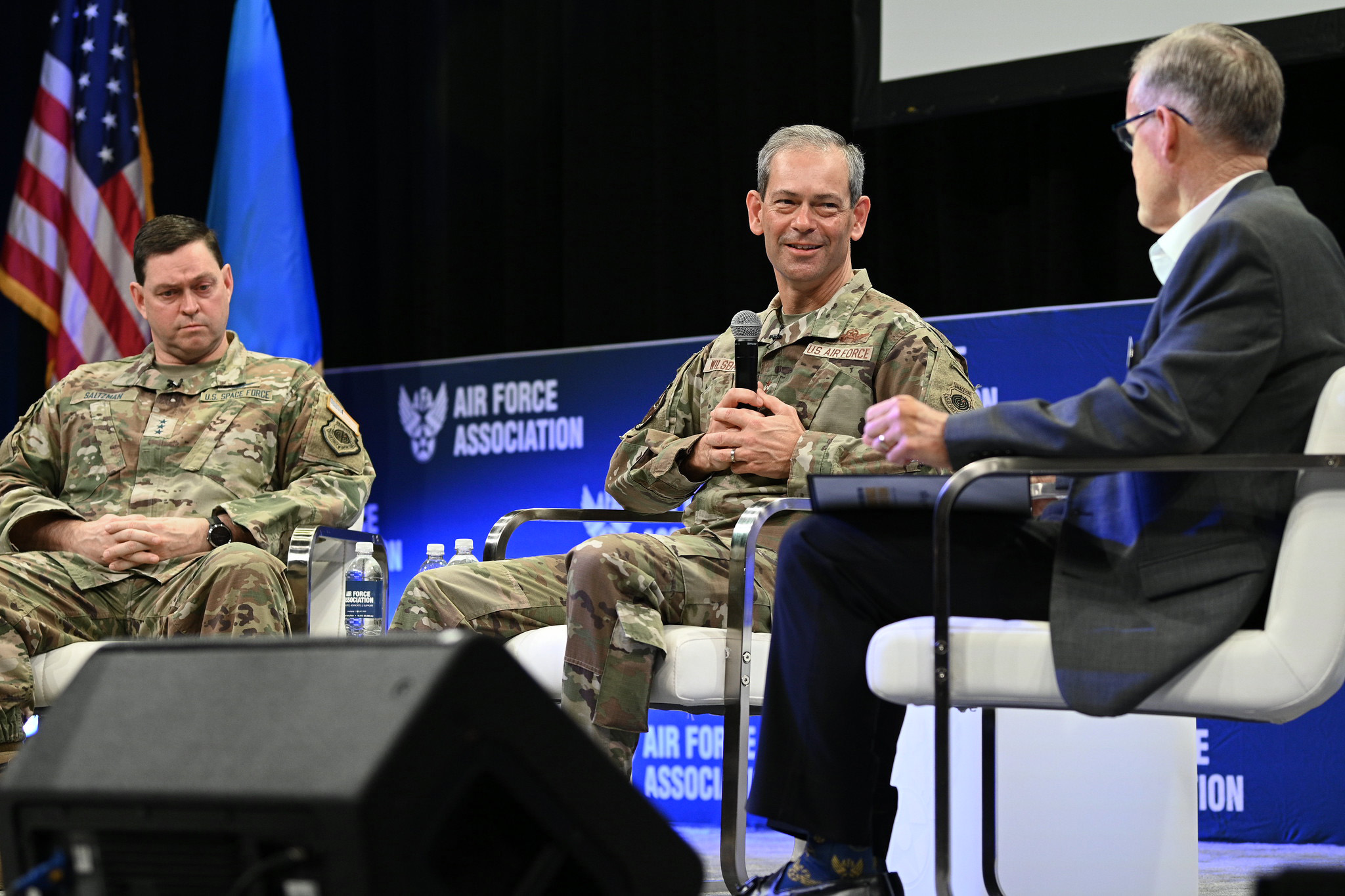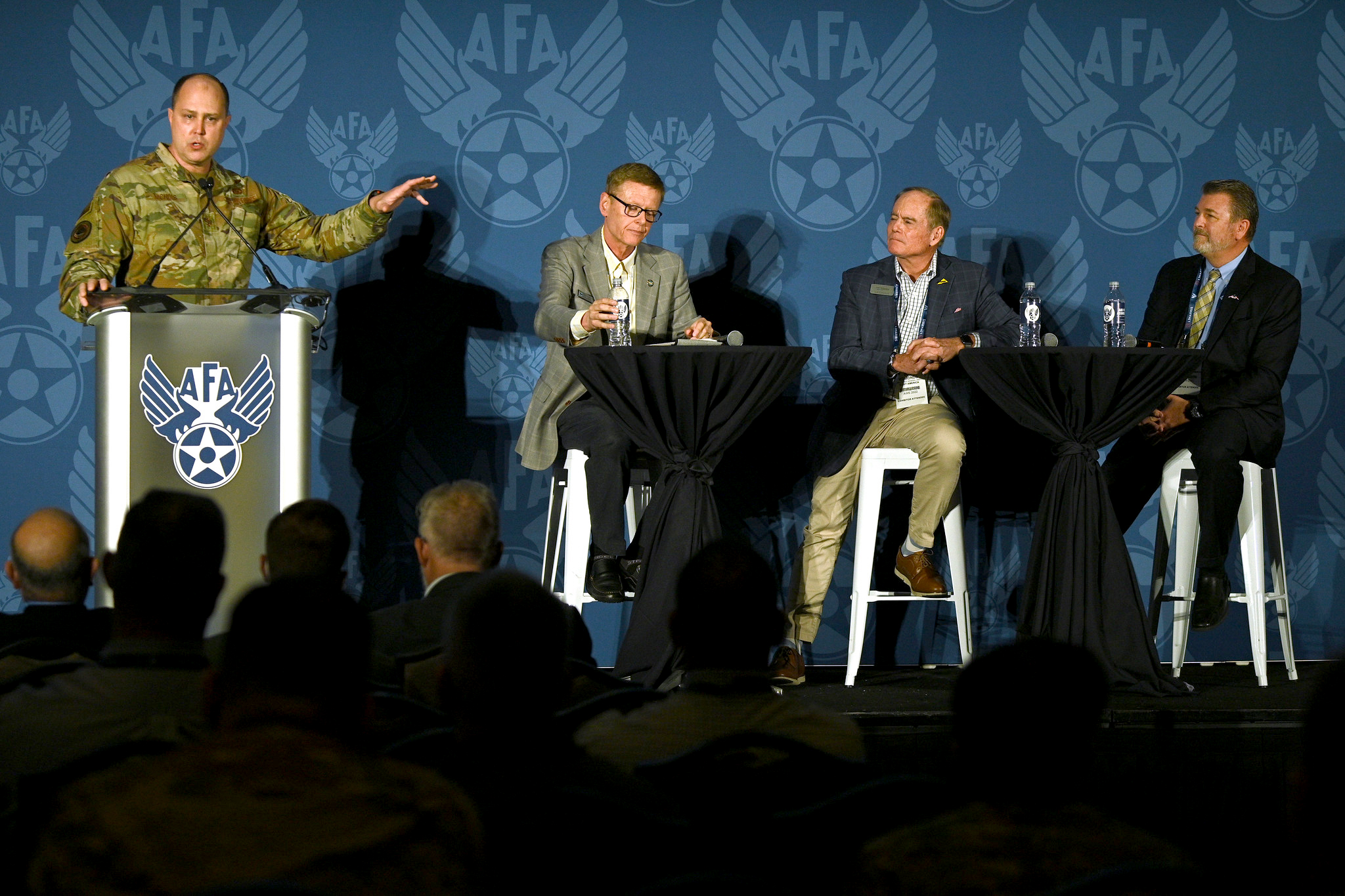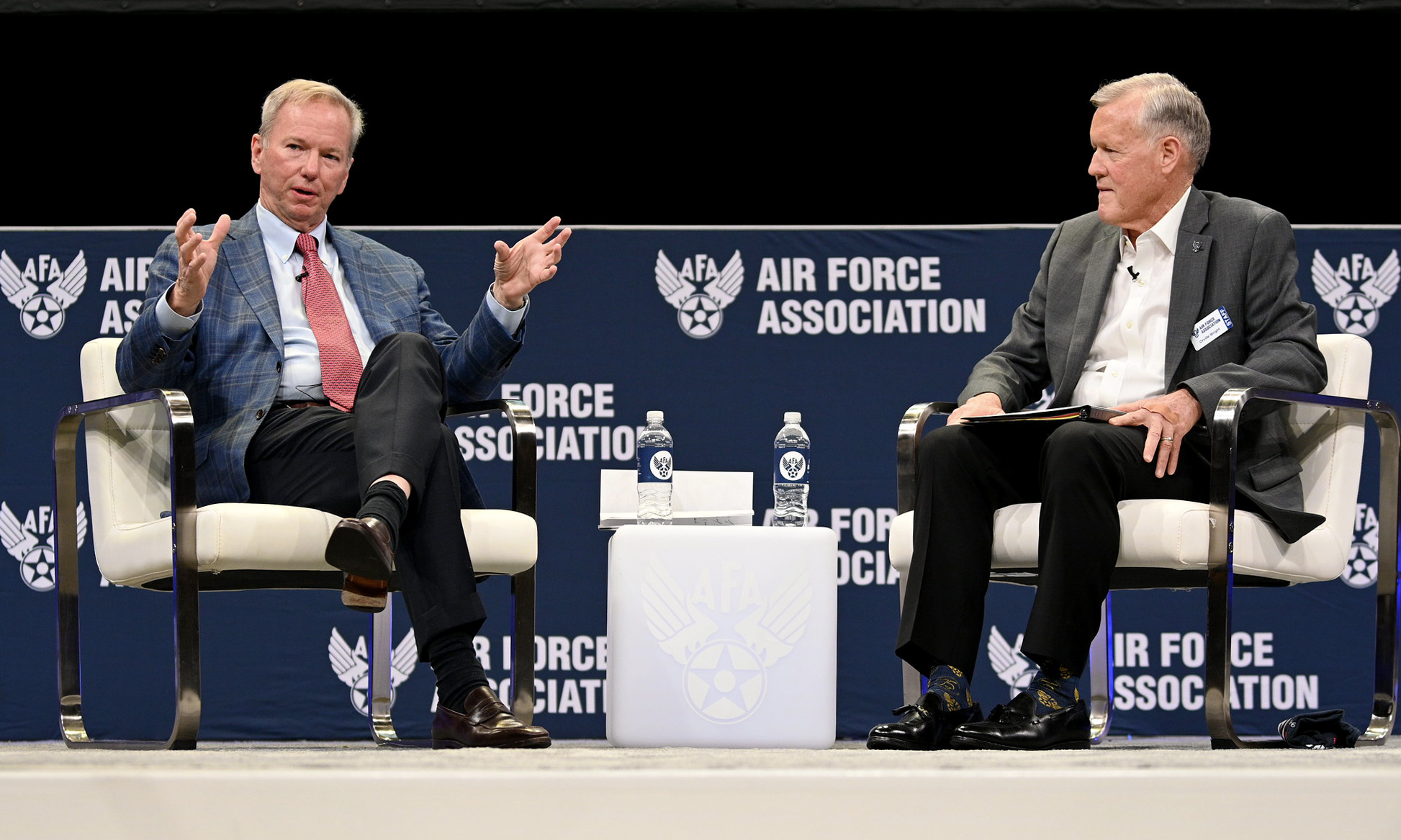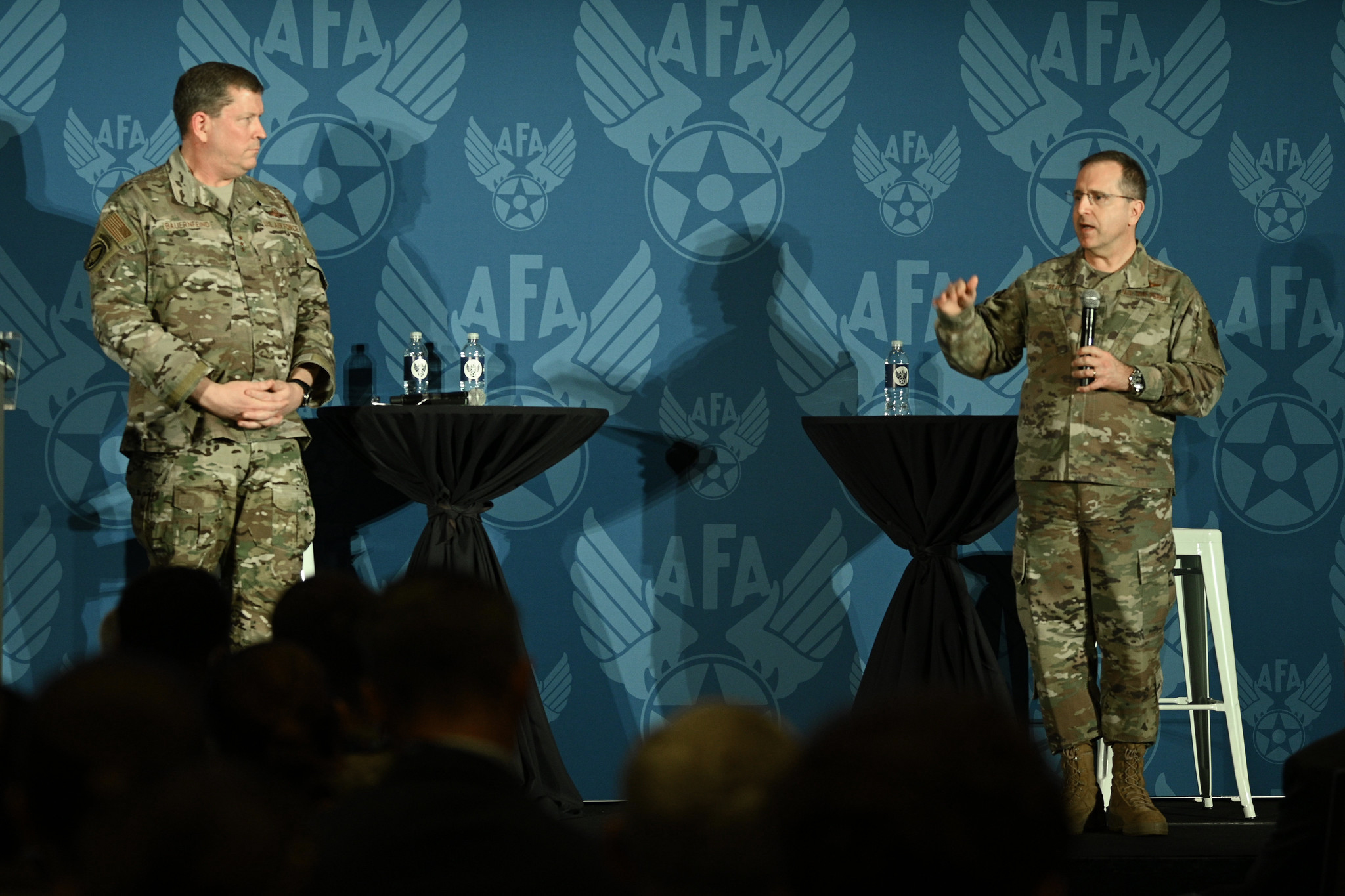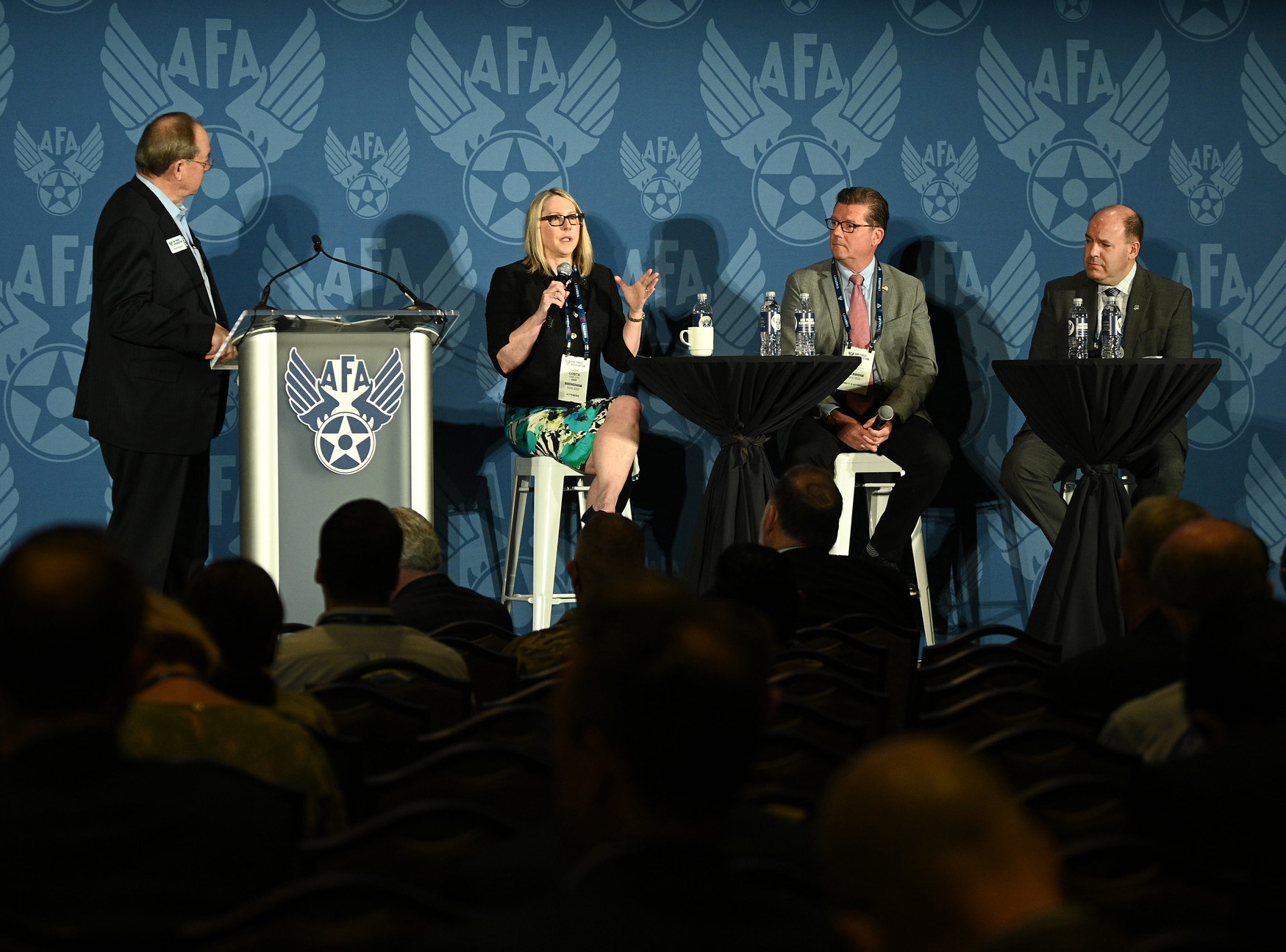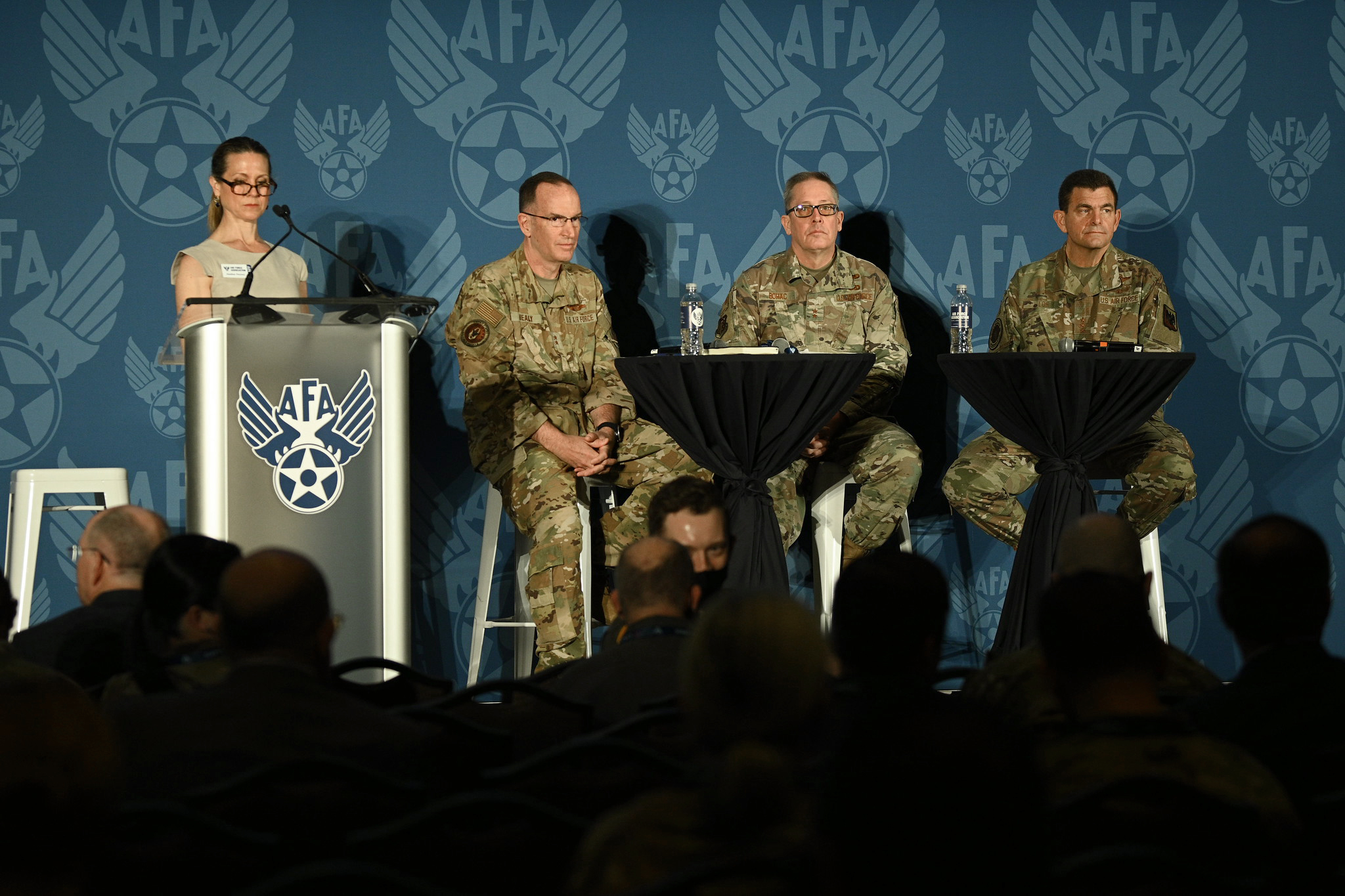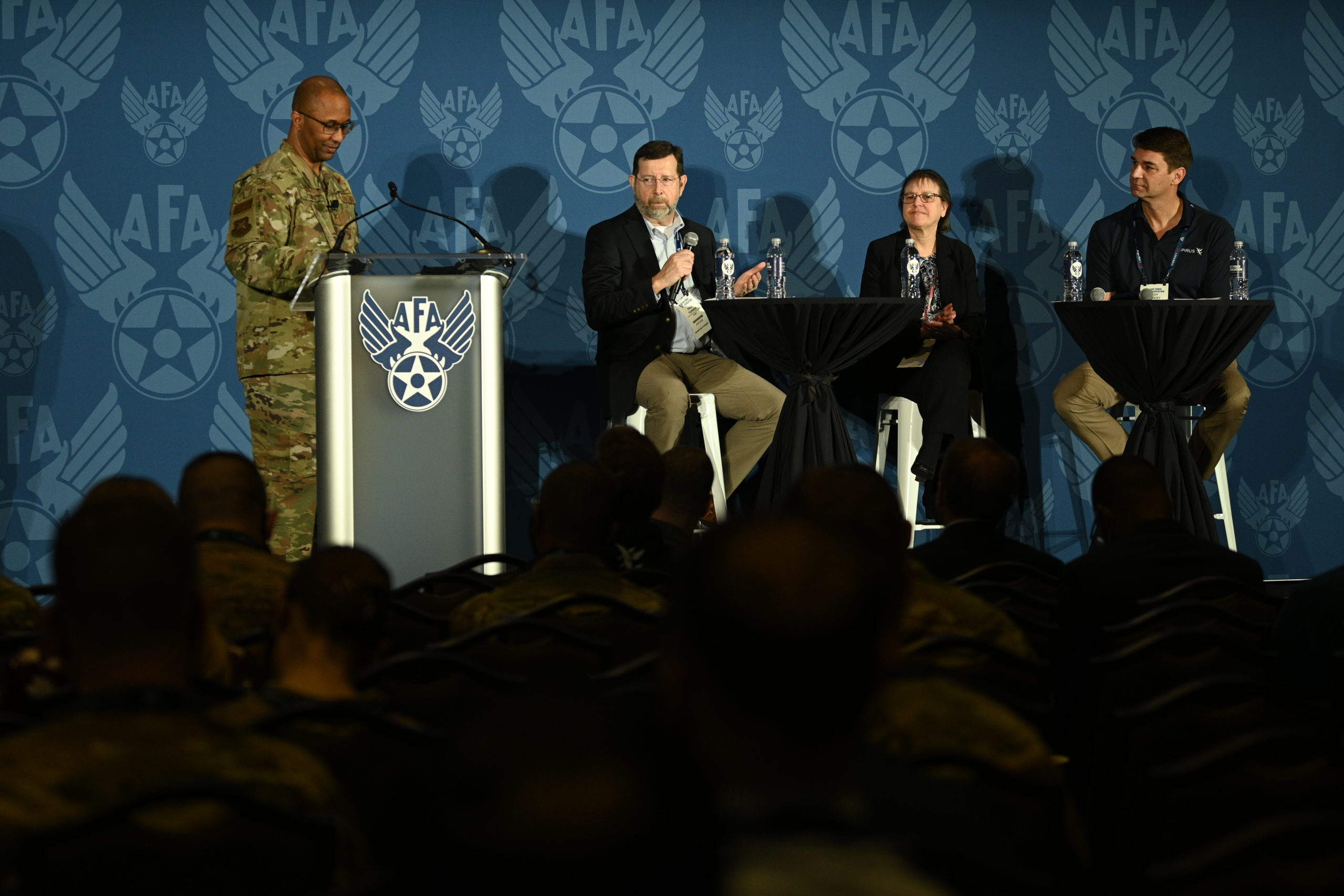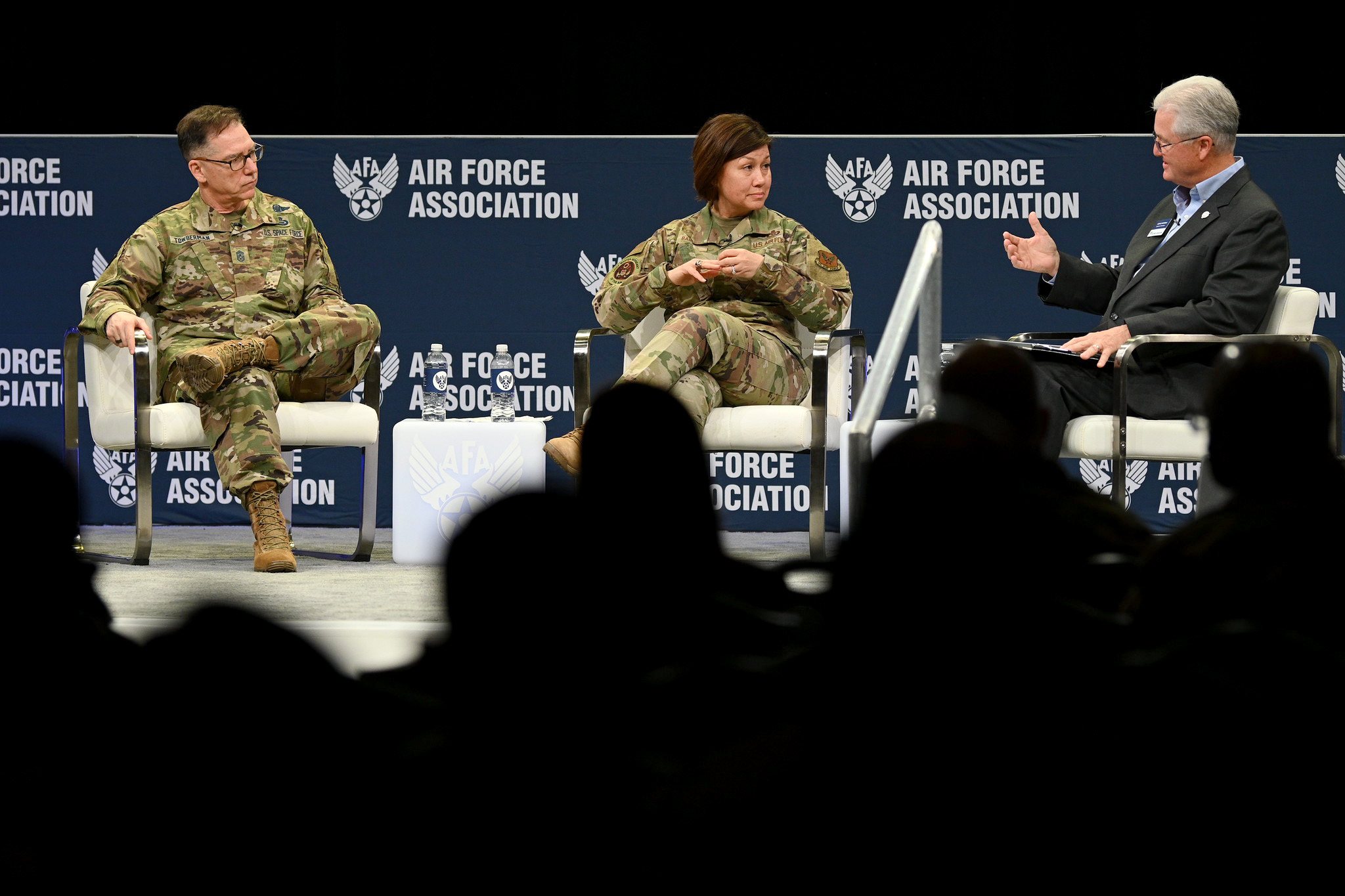Retired Maj. Gen. Doug Raaberg, executive vice president of the Air Force Association, hosts Lt. Gen. Steven N. Whiting, commander of Space Operations Command, and Gen. Mark D. Kelly, commander of Air Combat Command, in the discussion “Combat Air and Space Forces in the Fight.” This transcript is made possible through the sponsorship of JobsOhio.
Speaker: “Ladies and gentlemen, please welcome to the stage, the executive vice president of the Air Force Association, Maj. Gen. Doug Raaberg.”
Retired Maj. Gen. Doug Raaberg: “Thank you and good morning. Air Combat Command and Space Operations Command are the primary force providers of combat power to America’s war-fighting commands. ACC’s mission is to organize, train and equip combat-ready Airmen to control and exploit the air on behalf of the joint force. Likewise, SpOC’s mission is to protect America and our allies in, from, and to space now and into the future. In short, both commands must be prepared to close the kill chain while preparing for new capabilities to fight future conflict. I am delighted to be joined by Gen. Mark Kelly, commander, Air Combat Command. And with him is Lt. Gen. Steven Whiting, commander, Space Operations Command. Please give them a warm welcome.”
[Raaberg walks from podium to chair]
“Sir, delighted to be here. So let’s go ahead and set the stage. I think this is a very important discussion. So Russia’s president has launched an unprovoked assault on his neighbor. NATO has declared Article 4. SACEUR is now mustering even more of the NATO Response Force. So to begin with, I’d ask each of you to kind of discuss your role, your responsibility, your command as supporting commanders to coalition, air, and space war-fighting efforts. Gen. Kelly, let’s start with you.”
Gen. Mark D. Kelly: “OK. Well, thanks. I appreciate it. Always good to be here. Well, whether it’s Russia and Gen. Wolters and Gen. Harrigian’s challenges or whether it be Gen. Wilsbach, you know, and mock playing those challenges or CENTCOM or whatever, our Airmen wake up every day that we force provide in a more contested, congested, you know, geographic space, airspace, cyberspace, info space, and I’d argue, you know, outer space. And so they do so—and we have to make sure we train them to operate—they do so amidst the backdrop of already established crisis, whether that crisis be pandemic supply chain crisis, refugee crisis, climate change crisis, whatever.
“So the point is that we have to provide Airmen as a force provider to our force employers that understand that crisis competition and great power conflict is not the contingency plan. Crisis competition and great power conflict is the norm that we start with every single day. And so, to more to your question of what are we doing focused on, you know, EUCOM and USAFE right now: Every combatant commander wants more Air Force, Airmen, force elements forward because of the great work they do. I’m going to start with our great cyber Airmen. I’d love to sit up here and wax and wane about the great stuff they’re doing. It’s just the venue won’t allow me to do that. But if you were in the DOD, and you woke up and your computer didn’t just lock up, hug a cyber Airman. What they’re doing for our allies and partners is nothing less than miraculous. And they do so better than anybody on planet Earth.
“We’ve sent some command-and-control professionals over to help bolster Gen. Harrigian’s Air Operations Center. We’ve got the bulk of, I would say the bulk, but we’ve got every force element you might think of—of our ISR, enterprise big wing, less than big wing, manned, unmanned—given those commanders insight into a really daunting challenge that they need real time across every event you might think of. And then connected to that is the overarching intel enterprise that has to now assess and disseminate what they’re seeing to give those commanders that insight.
“And a little bit divorced from this conversation, but it goes to the ongoing catastrophe in Ukraine. I think when the books are written, this will be our intel enterprise’s finest moment—what they’ve done for the nation. The other piece is our battlefield Airmen. No one lashes up with our joint partners like our battlefield Airmen, and they’re doing that with our great Army and Marine and allies and partners. And then we need more base operating support because we’ve got more combat power over there. And all that is well prior to the shooters that we send over, whether they be F-15Es or the F-35s we just pushed for that lashed into Gen. Harrigian’s formation.
“So, like Gen. Wilsbach says, I could go on and on about how great our Airmen are doing. But there’s a lot of challenges in ACC every day with global force management, the demand signal for our Airmen and our capabilities. One of the challenges I don’t have is finding young Airmen that are willing to go to the sound of the guns when freedom of democracy is under threat. And so you have to be really proud of formations we push forward. So thanks.”
Raaberg: “Sir, that’s awesome. Gen. Whiting, your perspectives?”
Whiting: “Gen. Raaberg, thank you to you and the Air Force Association for having us. And it’s a privilege to be here with Gen. Kelly. You know, in 2019, just two and a half years ago, the nation had been watching the threats that we now face in our space domain and how China and Russia were trying to undercut and hold at risk the capabilities that are foundational to the joint force, and the nation said we have to have fundamental change. And so we created in August of 2019, we brought back U.S. Space Command to focus on the operational war fighting in the space domain. And then in December of 2019, the nation created the sixth armed force, the U.S. Space Force. There’s one organization that sits at the nexus of those two new organizations, and that’s Space Operations Command, or SpOC, the command that I have the privilege to lead. On the service side, we are one of the three field commands of U.S. Space Force, and we are the operational field command. So all presented space capabilities that support combatant commanders are resident within SpOC.
“So think of missions like space domain awareness, electromagnetic warfare, missile warning, missile defense, command and control, defensive cyber, ISR, SATCOM, GPS, as well as the installation and combat support capabilities that we have. And so we are the fight-tonight force of U.S. Space Force. But at the same time, we’re the largest service component to U.S. Space Command as the Space Force service component. And we bring the lion’s share of capability that Gen. Dickinson and the U.S. Space Command team execute in support of other combatant commands, like EUCOM, each and every day.
“As part of that SpOC presentation of forces, we have a two-star headquarters at Vandenberg, the old 14th Air Force headquarters, but it’s a service headquarters that executes joint missions each and every day. And that organization in the service is called SpOC West, commanded by Maj. Gen. DeAnna Burt, somebody that many of you know. But day to day, she serves as one of the two joint component commanders for U.S. Space Command, the Combined Force Space Component Command, and she’s back at home station doing great work on behalf of combatant commanders around the world right now. But that’s the role we play between these two organizations supporting the joint force.”
Raaberg: “Sir, that’s terrific. And especially for both of you as commanders looking 20, 30 years out, especially for force presentation. That’s a big job to look ahead. So, sir, I want to get back to you, Gen. Kelly. You know, you did mention crisis and competition as the norm. But let’s face it, we’re now getting into great power competition. It’s unfolding on the arena as we heard from the secretary just this morning. So what do you think should now be the key efforts going forward?”
Kelly: “As far as key efforts, you hate to give a ‘it depends’ answer, but you know, you can chop that into what I believe should be our national priority efforts: DOD, service, etc. We need to stay in our swim lane of, you know, ACC or SpOC or whatever the case may be, but you know, the secretary spoke earlier, the secretary and Gen. Brown, a member of the Joint Chiefs, you know, they participate in the national decision-making apparatus. The rest of us participate in the best military advice, you know, around everyone from a MAJCOM commander to a young Airman, we owe, by law, best military advice. And I think we owe best military advice in the context of crisis competition and great power conflict, you know, the appropriate advice for the appropriate level of sense of urgency, you know, that our nation will manifest in light of ongoing events.
“At the end of the day, our nation usually generates a national sense of urgency, usually, to strategic challenges, strategic setback, you know, whether it be a 9/11, Pearl Harbor or, you know, something, a strategic challenge, whether it be a space race or currently what’s going on strategic challenge. There’s a couple of ways we do that as a nation: Bottom up, when there’s a 9/11 or Pearl Harbor, there’s pretty much a bottom-up national sense of urgency. Going into, prior to World War II, the Manhattan Project was a top-down, driven sense of urgency. Dictatorships like China, Russia have adopted the top-down we shall have a national sense of urgency, but we need to make sure we convey unemotional, unambiguous, you know, advice to our senior leaders about what we believe.
“You know, if you talk to our partners and our allies that are in this room and elsewhere in NATO, I guarantee you there’s a sense of urgency amongst those folks furthest to the east of NATO, and you’ve seen that reflected already in just days, and the German government’s announcement of what they will do with respect to organize training and equipping and this new abnormal that we kind of find ourselves. And so we owe that; we owe that to our decision-makers. And we do so, the MAJCOM commanders do so, through Gen. Brown and the secretary. The other one, I’d say is a priority is to make sure we give good advice on great power capabilities.
“Earlier Gen. Saltzman made a comment about China’s FOBS, a fractional orbital bombing system, where they can put a hypersonic weapon in orbit over our country and deorbit it essentially at a time and place of their choosing. That is, without question, a great power capability. Also in Steve’s wheelhouse, you know, is, you know, Russia, you know conducting an ASAT. That’s unquestionably a great power capability. But our allies are also tracking this way. For example, Australia just committed a whole lot of treasure and effort to nuclear attack-boat capability. That’s a great power capability. We need to make sure every single penny, dollar, time, effort we commit for our nation, we can look ourselves in the eye and say, ‘That is for a great power capability.’ Because we’ll go to war, or we’ll go to conflict, or we’ll go to crisis with the capabilities we have.
“You can look today, what’s going on, the catastrophe of Ukraine, whatever the side you’re on whether you’re in the combatants in Ukraine or combatants in Russia, or our allies we’re bolstering in NATO, you execute this crisis with what you have, not what the program that’s going to show up in six weeks, six months, six years later, and our conventional capability, our Air Force and our Space Force and our other services, defined your conventional deterrence. So we need to make sure that our efforts are great power capability efforts.”
Raaberg: “So let me do a bridge here to you, Gen. Whiting, because this is really important. You’ve established three core competencies for the Space Operations Command: intel, space operations, cyber. So how does your command now integrate these three elements to achieve space superiority based on what Gen. Kelly was talking about?”
Whiting: “Yeah, thanks for that question. In SpOC, our No. 1 priority codified in our strategic plan is to prepare combat-ready ISR-led cyber-secure space and combat support forces. Let me unpack that because we chose those words very carefully, because they do truly guide the actions that we are taking on a day-to-day basis. No. 1, combat readiness. As I mentioned, we’re a fight-tonight force, and so combat readiness is the coin of the realm, and SpOC, everything we do has to promote the combat readiness of our assigned deltas and squadrons.
“And then we talked about being intel-led. I think one of the most exciting developments in the Space Force was when we were stood up, we went and found all the units across the Air Force that were doing space intel, or intel for space. And we brought them home now to Space Operations Command, and we put them resident into Delta 7, which is our ISR delta. And they now are working to leverage all of the intel community’s capabilities, including Title 50 authorities. And what we’ve done is we’ve put all those intel Guardians and Airmen in that delta, but then they have created detachments that are aligned against all of our other mission deltas. So if you’re in Delta 4 doing missile warning, missile defense, you have a detachment from Delta 7 that’s bringing you the relevant intel to enable your operations about those threats to your system. So everything we do has to be relative to the threat, and over the next few years, we’ll be growing three additional intel squadrons as part of Delta 7 to continue to robust that capability.
“So again, combat-ready intel-led, cybersecure space and combat support forces. Gen. Kelly talked about the great work of cyber Airmen. We are seeing that as well with our cyber Guardians and Airmen. Space networks, space weapons systems, by their very definition are global. They wrap around the planet to enable our expeditionary forces to go anywhere and operate. But they also extend 22,000 miles above the Earth’s surface out to geosynchronous orbit and beyond as we think about cislunar. And that creates a novel cyberattack surface. Now certainly countries like Russia and China are developing capabilities to take us on in space, go after our physical satellites. But other countries, like Iran and North Korea, they’re not quite that sophisticated yet, but they want to take us on in cyber, as do of course, Russia and China.
“So we’ve got to protect that soft underbelly of our space weapons systems with our defensive cyber capabilities. And that’s something we are rapidly working to expand. We’ve had some real exciting advancements recently. And then we talked about how being ICLR-led cyber secure pulls together space and combat support forces. We can’t do our space missions without those intel and cyber Guardians and Airmen. And then our bases and stations, those are not just the places that we live and recreate. Those are our power-projection platforms. The vast majority of our space capability executes from home station, and just like jet fuel literally fuels the U.S. Air Force; electrical power and HVAC fuel the United States Space Force. So those operating locations are absolutely vital to our combat readiness. So that’s how we think about pulling all those capabilities together to execute our space missions.”
Raaberg: “Sir, that’s, that’s amazing because you take the three core competencies, you’re integrating them into each of the deltas, so it’s almost like a combined arms within the command to be able to fly and fight and win out of space and through. So that’s incredible. I can imagine you both are lighting up a lot of telephones right now with other commanders, specifically component commanders and their COCOMs. You’re right now trying to look at today’s events and trying to shift from your MAJCOM level. So really, how are you preparing to provide those requested force capabilities? So Gen. Kelly?”
Kelly: “As far as the methods we use, mine is almost exclusively through the components. I’m in communication with the combatant commanders. They’re pretty busy folks. And so and their components are supposed to be the air and space and cyber experts for their for their combatant command. And so I’m in pretty close contacts with Gen. Wilsbach, Gen. Harrigian and Gen. Guillot. Sometimes I’ll reference Gen. Guillot. He’s here. So say hi to him. But sometimes people confuse superior subordinate commander with supporting, you know. I’m essentially an overpaid support team commander to Lt. Gen. Guillot, and he unambiguously lets me know when he’s not getting everything that his command commander needs to close their risk and execute the commander’s objectives in the theater. And so my efforts are essentially through the component commanders. And we’ve got great, great relationships. Sometimes there’s an adjudication in GFM, if you would, in the joint staff, and that’s just the normal process that we go through. And so I’d say, if I’m answering your question correctly, just through the component commanders almost exclusively.”
Raaberg: “So, Gen. Whiting, same question, but a little different, because there’s a transition going on in terms of the director of Space Force, the DIR Space Force construct, now kind of shifting to that we talked about this morning the SFSC, so DeAnna Burt in this case. So who are you talking to and trying to get a good assessment for your command’s ability to provide that capability?”
Whiting: “Yeah, as we think about space support for our forward-deployed terrestrial forces and combatant commands, it happens at all levels. Of course, U.S. Space Command’s engaging in a combatant command level with those other combatant commands. I have a relationship with other component commands that are in those combatant commands. And then as you highlighted, Gen. Burt with her Combined Force Space Component Command, we have very routine now and habitual relationships from her Combined Space Operations Center, the CSpOC, out to those other theaters through the directors of space forces. Each and every day, they’re submitting space support requests. We’re fulfilling those requests, working on their planning together, they’re working in support of our planning. A very robust relationship.
“Now that will start to evolve here in the coming months as we stand up Space Force service components in those other combatant commands. Those director of space forces positions will shift to that service component role for U.S. Space Force. But we think that those habitual relationships and those processes that we’ve developed will continue to be very robust. I’ll also highlight that those relationships extend beyond just U.S. combatant commands. We have very rich relationships with key allies and partners like the United Kingdom, Canada and Australia. So each and every day out at Vandenberg at the CSpOC, they’re also executing space support requests from those countries through their national space operations centers, and then they’re bringing their space capability to bear for this enterprise as well. So multiple layers that we’re supporting downrange commanders.”
Raaberg: “Sir, can I tap on a little bit more? How about Space Command itself? How do they help shape your thinking, especially today? And then looking downrange?”
Whiting: “Yeah, absolutely. So service component, of course, I’m, you know, under the command of and responsive to Gen. Dickinson, our combatant commander. He has created teams that from his headquarters at U.S. Space Command that live in other combatant command headquarters. So if you go out to INDOPACOM, there’s a team of planners there that come from U.S. Space Command. So that’s an important relationship as we’re doing campaign planning with those other combatant commands to make sure that we have those relationships right. So everything that we do is in support of his operational scheme maneuver.”
Raaberg: “Sure, thanks. Gen. Kelly, a little shift here in terms of more downrange thinking, and I’m pretty sure there’s somebody out there and on the other side of the pond, especially in INDOPAC, who are going to be listening to what you say. And that is, for combat air forces, what are some of the conventional capabilities that Air Combat Command must field now so our nation can really compete and win against a peer adversary.”
Kelly: “So as far as a conventional capabilities, we need to provide that conventional deterrence needed in each theater. Gen. Wilsbach mentioned earlier there was a question to him about Agile Combat Employment. And we’re really doing well in CENTCOM with Agile Combat Employment in Europe and the Pacific with Agile Combat Employment. We do that for several reasons. One is to complicate the targeting picture for any adversary to make it unpredictable for them but predictable for us. But the fact is, the other reason we do it is just the lethality of airbase threats that we face all over the globe. And so, although it’s a capability that ACC doesn’t necessarily provide, our airbase defense is a capability that we need to have a discussion on, you know, as a nation as we go forward.
“Russia is having an unending number of challenges right now executing their campaign, and I’m not going to grade their homework and how they’re executing. But one challenge they’re not having is airbase defense on their main fighter operational bases, because they have layer upon layer upon layer of SA-21s, SA-23s, SA-20s, SA-10s, etc., that they come and go freely from. Our partners that are here in the crowd that I’ve talked to last night and today, our Israeli partners, wake up every day under the curtain of an Iron Dome. I was talking to our Finnish partners. They do some agile combat employment on highways and byways in their nation. They taxi into Granite Mountain. The great sailors of our Navy operate, obviously, with maneuver on the high seas, but they do so under the protection of a whole lot of Aegis cruisers and destroyers of SM-3s and SM-6s. There’s a reason why those nations and those service partners operate with that. And that is a threat to risk to force that we push forward. And if we can mitigate that risk to force, we will continue operating a little bit further outside than we’d like to. So airbase defense would be the first thing I would say.
“The second one is what Gen. Wilsbach references: air superiority. Again, what’s going on in Ukraine with the combatants there, whether it be Ukraine or Russia, it speaks volumes to your superiority when you don’t have it. Our joint force is organized, trained and equipped. And I would go so far as to say the Russian joint forces are organized, trained and equipped to operate with their superiority and not remotely without it. And you’re getting an optic of what it looks like to operate without it with holes being punched in your formations, because you can’t establish air superiority and then provide, you know, close air support. Same thing with our Air Force and our joint force. We owe the joint force air superiority, and they’re expecting it to be there when game day shows up.
“The other one, and the secretary mentioned of AMTI, we have to be able to sense the air domain to provide that picture overall, whether it be at the airbase or whether it be in the air superiority fight. Gen. Wilsbach also mentioned essentially what I refer to as fifth-gen weapons for fifth-gen platforms. We as a nation have put a lot of time and treasure and effort into a low observable force, whether that be Tony Cotton’s B-2s and then will become B-21s or whether it be F-35s or F-22s, you name it. We will not get a phenomenal return on investment if we push a low observable force in due to weapons to a range where everyone is observable. And so that’s the other piece that I think we’re in violent agreement on.
“The other that the secretary talked about as well is JADC2. You can see through, again, that some of the challenges that Russia is having is executing is, if you don’t have joint all domain command control, it gets really chaotic, really, really fast. And you it’s not just a distraction, it’s a loss of life. So the JADC2 piece will be contested and congested again in any theater.
“And then the last one, I would say is every platform we have or will have, we needed to go further, sense further, shoot further. And so some of that incorporates not just fifth-gen weapons for fifth-gen platforms but fifth-gen sensors and fifth-gen weapons into fourth-gen platforms. It provides a disruptive impact to a peer fight. And so we owe that advice to our leaders.”
Raaberg: “Sir, we may come back to that—talk about how you really integrate and exercise that future capability that you’re looking for, as an OT in need. Gen. Whiting, kind of on a similar vein, but let’s face it, Guardians and Airmen are orchestrating the vertical integration of space. So let me throw the reversal back at you. So what is the role of Airmen in executing SpOC’s mission?”
Whiting: “Yeah, I really appreciate that question. There was a very smart decision I believe made by the secretary of the Air Force when the Space Force stood up, and she at the time directed that, for the purposes of military justice, the Air Force and the Space Force are one service. What does that mean? That’s how the Marines and the Navy operate. And it’s why, if you remember the movie ‘A Few Good Men,’ when Col. Jessup was being court martialed, there were both sailors and Marines on that court martial, because otherwise you couldn’t do that. But what it really means is that the Airmen assigned to SpOC and the Space Force, they are fully inside of our chain of command. Similarly, when Guardians are assigned to an Air Force unit, they are a part of that chain of command. So it allows us to truly operate as one team executing our one fight.
“So that’s why you’ll never hear me or the leadership of SpOC, talking about our personnel and just saying ‘Guardians,’ its Guardians and Airmen. Because when the Space Force was created, we only had five career fields that were allowed to transfer in. The first three are officer and enlisted career fields, Space Operations, intel and cyber, and all the various shreds of those. And then two officer exclusive career fields: acquisition and development engineer. Everything else that it takes a uniform body to execute a service’s mission comes to us from the U.S. Air Force. So when you drive through the gate at Peterson Space Force base or any of our other locations, it is a professional Airman defender there at the gate defending that installation. CE, medics, chaplains, logisticians, personnelists, all of that comes to comes to us from the U.S. Air Force. And those are foundational members of all that we do because they run those installations, which are those power projection platforms that allow us to execute our missions.
And so we cannot do our mission without those Airmen. And even in our space-focused units and our space deltas and space squadrons, the individual personnelists and administrators and in our deployable capabilities, the age maintainers, all of that is from the U.S. Air Force. So we just can’t say thanks enough to our Air Force teammates, in particular Air Force Materiel Command, who’s the servicing MAJCOM, who supports us and their subordinate centers like IMSC. Just an incredible relationship, and we can’t do our mission without those Airmen.”
Raaberg: “Sir, sounds like one team, one fight. Thank you. Gen. Kelly, last September, many of us heard about and saw that you unveiled the fighter roadmap. Given current events, how does it stand now?
Kelly: “If anything, current events, just enforce, you know, where we need to be ready for crisis competition and great power conflict. And as I mentioned just a minute ago, you see every day, unfortunately, the catastrophe taking place there. But from a military standpoint, you see the disasters that unfold in the military lane, when you don’t establish their superiority over a contested environment. You also see, you know, every every really huge problem is a logistics problem. And if you think logistics is hard, from the border of Belarus, down in Kyiv, you should try it in Gen. Wilsbach’s AOR when there’s a whole lot of water, and there’s a whole lot of air, and there’s a whole lot of threat to what you’re doing.
“But to your point of the fighter roadmap, what we’re seeing play out, you know, in Ukraine, and what we’re seeing every day in crisis competition and great power conflict in Asia-Pacific, just really reinforces that we have got to first and foremost, bring in electromagnetic spectrum and everything we do, because the force that can thrive and survive in that environment will be the one that ends up succeeding in the end. And as I mentioned a minute ago, everything we field forward has to go further, see further, sense further, jam further, shoot further, just because the range is involved in this high-end tech combat.
Raaberg: “Gen. Whiting, on a similar note: strategy. You probably have an unclassified and classified strategy tools, obviously stick on the open-source side. Give us some insights on which strategy you’re developing or have developed and how is it going.
Whiting: “Yeah, let me talk about a couple initiatives that we’re working, one being in a field-comm level integration CONOPS and the other being a unitized training effort. You know, one of the most formative assignments in my career was the one time in my career, Gen. Kelly, I was assigned to Air Combat Command. As a new one star, I was the vice commander of the Air Force Warfare Center at Nellis. What an incredible job. Had two awesome bosses, then-Maj. Gen. Jeff Lofgren and then-Maj. Gen. Jay Silvaria. And yet, I showed up as an officer with a space background and never having served in a unit whose primary mission was flying, and they said, they did not say sit in the corner and wait for the space issues to come. They said lean in, lead here.
“In fact, for two and a half months, I was on G Series orders as the commander of the warfare center because Gen. Lofgren got deployed and, Sir, your predecessor Gen. Haase called me and said, ‘Steven, we don’t know who’s coming in behind him. So you got it. OK, so let’s keep leading.’ I did try to direct the Thunderbirds to paint the jets black in honor of space. They absolutely ignored that order. So I’m sorry they were so insubordinate, but what an incredible unit to actually get to be around is the Thunderbirds, incredible Airmen.
“But I learned that yes, Nellis is the, you know, the home of the fighter pilot, but it is the home of tactical integration, not only for the U.S. Air Force but really for the Department of the Air Force in many ways and, I would say, our Joint Force. Because I learned there that the Air Force has not built one exquisite aircraft to go against like a double digit SAM or, you know, advanced SAM threat. They have the force package capability. So they have to bring together high-value assets that are vulnerable, like JWACs and JSTARS with offense, with defense, with ISR, cyber, command and control joint fires, to take down those threats and execute a mission.
“Well, that is exactly what we are having to do now in space with the threats that we have to, you know, defeat in the space domain. So we’re writing an integration CONOPS that that looks at how do we bring together the capabilities of all of our deltas, and what are those TTPs, as we think about bringing together space domain awareness capability, high-value assets like SATCOM and missile warning that we have to protect? Offense, defense, space control capabilities, ISR, cyber, command and control to make sure that we can survive in the face of these threats. And so later this year, we will complete that initial work and have a CONOPS that walks through how we do that.
“And then I’ll also highlight one additional initiative, which is what we’ve called our unitized training effort. When we were in the Air Force, of course, our wings all had an operation support squadron that did a whole disparate set of functions that supported operations. Some of that was supporting the training of our space missions in those wings. Some of it was doing important functions like running the airfields, executing weather and intel operations. And those of you who have served in OSS, as you know, you kind of serve as the the group staff or the OPS group commander.
“Well, as we broke apart our deltas and garrisons, the airfield and the weather, those went to the garrisons run by Airmen doing fantastic work. So those kind of left the OSSs. Intel went to Del. 7 and then was presented back as a detachment to those supported deltas. We didn’t really want a a squadron being the group staff anymore, so that kind of left us with training. So now we’ve stood up combat training squadrons or detachments in each of our deltas to execute our portion of the training pipeline, which is IQT and advanced training. So now we have a commander and a senior enlisted leader and their team who show up every day focused on our core training tasks. It also serves as a belly button to work with space training and readiness command, one of the other field commands, who has other training responsibilities that are critical for the service. So those are two initiatives that we’re working to really get after the space missions that we’re responsible for.”
Raaberg: “Sir, thank you. Let me shift stressors that you see, especially in organizing, training and equipping. So, Gen. Kelly, any particular unclassified capabilities you see as stressed, and really needing your attention, whether that’s ISR, unmanned combat, search and rescue?
Kelly: “In terms of force element stressors, at the end of the day, it’s really across our entire combat air force that combatant commanders want more of our Airmen, more of our equipment, more of our aircraft, the force elements I mentioned earlier, because they perform so well. But, you know, for our nation and for our Air Force and DOD, on September 12, 2001, we appropriately as a nation, as an Air Force, went into crisis action, global force management and sourcing to answer the nation’s call and respond to 9/11 attacks. It made perfect sense.
“The challenge we have is that we followed that week of crisis action, global force management and sourcing with another 1,000 weeks of crisis action, global force management and sourcing for the counterinsurgency crisis of the week. And when you do that, and you consume an air force at a rate that exceeds your ability to generate an air force, no different than you, doesn’t matter if it’s muscle tissue or money or combat power, you consume at a rate that exceeds your ability to generate it, you’re going to bet there’s going to be some after effect.
“And the after effect for us was we literally ate the muscle tissue of the Air Force. And so that’s one of the reasons why our four-bin model is a sustainable force presentation model so that we don’t work in this age of crisis competition and great power conflict, and we throw another crisis on top of it of a readiness crisis. Because we have to have enough combat power during this time to go forward should crisis boil over into a kinetic conflict. But there is no one specific force element. It’s all in demand. All the ones I talked about: our cyber Airmen, our command and control, our ISR and other intel Airmen, our base operating support, our battlefield Airmen, and of course, our shooters across the globe. And so, no, it’s all under pressure, and we just owe them the right organizations, the right training, the right equipping, so they can go forward and succeed.”
Raaberg: “We have probably a little over five minutes remaining. But what I want to do is, it’d be remiss if we didn’t touch on Agile Combat Employment, especially from your perspective. And really Agile Combat Employment, as we’ve already heard from Gen. Wilsbach, is already executed. You’ve been the leading edge of the testing development and putting it out into the field itself. How’s it coming along?”
Kelly: “It’s really, as Gen. Wilsbach mentioned, and if Gen. Harrigian was here, he would also echo that it’s going really well. You know, it’s no longer a niche thing that we do, because it comes around the calendar, like, hey, let’s sprinkle in some Agile Combat Employment. It really is mainstream. And I mentioned Gen. Guillot earlier, and I’ll mention him again, I sometimes when I talk to him, I’ll let him know that I’m having trouble keeping up with where he’s pushing the forces to, because they take off out of one base, and they’ll refuel at another, and then they rearm at another, and they’ll spend a night at a fourth. And then they’ll end up, you know, doing some other operations.
“And so I have trouble keeping track of where he’s pushing all these forces, which is actually a compliment. Because if I have trouble keeping track, the Iranians and the Syrians have trouble keeping track of what we’re doing. And the Airmen, and I mean Airmen from people that are fueling and fixing and loading and maintaining, as Gen. Wilsbach mentioned, are multicapable Airmen. They don’t just survive in this environment; they thrive in the environment. And same thing with our operators and our commanders. And those command channels, the C2 of it, get stressed, and we learn every day, we get better. But I would say AFCENT is essentially the operational test grounds of Agile Combat Employment because they do it literally habitually now.”
Raaberg: “So, Gen. Whiting, so what is the difference for the SpOC when it comes to Space Force deployment? Really give us some insight on that.”
Whiting: “You know, the vast majority of our capability employs from our bases and stations, which is why those power projection platforms are so important to us, as I highlighted. So gotta really watch the readiness of those capabilities. And in fact, we have a whole effort ongoing to look at the infrastructure readiness and how it supports those missions and excited about where that will take us here in the months and years ahead. We do have some traditional deployable capabilities that look a lot like I’m sure Gen. Kelly’s fighter units, for example, when they rotate downrange, and we run them very similar model to what he described with that, that force generation model.
“I would like to highlight a change we made in our headquarters because as we moved away at Building One at Peterson, which used to be headquarters, Air Force Space Command, we’re no longer that organization. And for about a year, we were headquarters, U.S. Space Force, as the staff at the Pentagon was getting stood up. And we’re no longer that organization. We have created inside of our headquarters, mission area teams that align to our deltas. So if you were at Delta 8 doing the satellite communications and GPS mission that is vital to combatant commanders around the world, you have a team led by an O-6 or a GS-15 at our headquarters, and that team has 20 to 30 people. Their job is to support your current operations, whether that’s deploying downrange or executing from home station. But also looking at all of the upgrades and new weapon systems coming in the POM and making sure that we’re ready from DOTMLPF perspective to feel that capability when it lands. That we have the people, we have the facilities, we have the doctrine that we need. And so that’s a vital effort that we’re pivoting to in our headquarters to support those deltas.”
Raaberg: “A couple minutes remaining, so about a minute apiece, but I want to prime the pump real quickly, and that is and this may be a leading-edge question, and that is, you know, are your priorities changing or is your lens changing based on Putin’s escalation dominance and Xi’s grand strategy to upstage the global order?”
Kelly: “Short answer, I would say is no. It just really, you know, 99.99% of this catastrophe in Ukraine is horrible. The offshoots of that are, you know, a couple years ago, maybe less than a couple years ago, you know, there’s discussions about the relevance of NATO. I don’t think we’re gonna hear that conversation anytime soon. More into Tony Cotton’s swim lane, and Adm. Richardson’s, you know, there’s discussion and debate and it’s healthy, over does this nation need a nuclear triad? I haven’t heard that debate lately. Sometimes we get discussion over the requirements to fully fund nuclear command and control. Now, I think there’s real big debate on the relevance and importance in the no-fail mission of that.
“But in terms of more in my swim lane of ACC, being a good force provider to all the components and the combatant commanders, short answer is no. Those actions of a dictator essentially taking over a smaller democracy just really reinforces what we do to train our Airmen. Like I said, there’s a lot of challenges in ACC. Finding Airmen to go forward to the sound of the guns and defend democracy and freedom is not one of my challenges of the day. And I just need to make sure we give them the training and the equipment and the guidance and the courageous leadership they deserve. Because these are the professional sons and daughters that their parents loaned to us, so we owe them back in good or better shape than we got them. And the best way we can is to make sure they are organized, trained and equipped to exceed and represent our Air Force and nation.”
Raaberg: “Gen. Whiting, thank you. Gen. Whiting, we’re down to about 15 seconds. So bonus round. Final thoughts.”
Whiting: “I agree with Gen. Kelly. You know what China and Russia are doing just validates what we’ve always thought. I got to watch in 2007 in real time as China conducted that very irresponsible ASAT test, and we knew, those of us sitting in the room, it included Lt. Col. Chance Saltzman and Maj. DeAnna Burt, that the world had changed. Sometimes our body politic takes a while to move. But we have shifted now as I highlighted in 2019, a new combatant command, a new service, dedicated to the space domain for one purpose: to ensure that the space effects we provide—that increased joint lethality and effectiveness—are available in the face of the threats we now face and across all phases of conflict. That is our moral responsibility to the joint force.”
Raaberg: “Generals, this has been a wonderful conversation with you. Thank you. And for our audience, in lieu of speaker gifts, AFA is funding more Airmen and Guardians to attend tonight’s poolside barbecue. So come join them. And thank you for supporting our Airmen and Guardians.
“Ladies and gentlemen, it’s time for the coffee break, and I know everybody needs the doors open to get out of here. So join us in the expo hall and check out the exhibits and displays. Meet our industry partners and come back here at 10:45, probably a little later than that, because I don’t have a good shot clock anymore. Thank you very much.”

